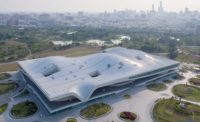Part landscape, part architecture, the 1.51-million-square-foot National Kaohsiung Center for the Arts blurs the boundaries between indoors and out, solid and void. Floating at one end of a 116-acre park that had been a military base before the project began 12 years ago, the $280-million complex brings together four performance spaces under one enormous roof and a fifth one on top of it. To get from one venue to another, visitors navigate a matrix of spaces flowing around the elliptically shaped halls. Covered, but open to breezes and views of the park, this fluid matrix provides a cool retreat from the sub-tropical sun and frequent rains—serving as a public plaza where anyone can come to do tai chi in the morning, jog in the afternoon, or relax in the evening.
Inspired by the large banyan trees that grow on the site, the Dutch architecture firm Mecanoo designed the building so it has curving steel panels that wrap around the auditoria and rise to connect above the plaza like a leafy canopy. The architects worked with Dutch and local shipbuilders to fabricate and install the steel panels, a nod to Kaohsiung’s history as a port city on the southwest coast of Taiwan. The quarter-inch-thick panels are welded together and retain the rugged look of a “cargo ship, not a yacht,” says Francine Houben, founding partner and creative director of Mecanoo. In Kaohsiung, night markets and street performances animate the public realm after dark when temperatures drop. The architects hope their Banyan Plaza works in the same way, luring people to dance, sing, and sketch, while others come to attend ticketed events indoors. “We wanted to capture the city’s wonderful mix of informal and formal,” states Houben.
Both the standing-seam aluminum roof of the building and the concrete floor of the plaza roll like hills in the land. On one side, the roof dips down to touch the ground and form an outdoor amphitheater with stepped seating that allows visitors to climb part of the building. The indoor venues range from a 2,236-seat opera house to a 1,981-seat concert hall, a 1,210-seat playhouse, and a 434-seat recital hall. People attending performances enter the individual halls from the public plaza and can also circulate from one venue to another on the third level, which the architects liken to the “crown” of banyan trees touching one another.
The plaza opened to the public on October 10 and the National Kaohsiung Center for the Arts’ executive and artistic director Chien Wen-Pin conducts the inaugural concert on October 13.











Post a comment to this article
Report Abusive Comment